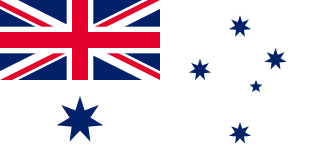
The Royal Australian Navy (RAN) is the naval force of the Australian Defence Force (ADF). The professional head of the RAN is Chief of Navy (CN) Vice Admiral Mark Hammond AM, RAN. CN is also jointly responsible to the Minister of Defence (MINDEF) and the Chief of Defence Force (CDF). The Department of Defence as part of the Australian Public Service administers the ADF.
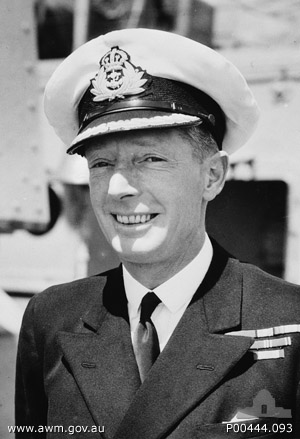
Vice Admiral Sir John Augustine Collins, was a Royal Australian Navy (RAN) officer who served in both World Wars, and who eventually rose to become a vice admiral and Chief of Naval Staff. Collins was one of the first graduates of the Royal Australian Naval College to attain flag rank. During the Second World War, he commanded the cruiser HMAS Sydney in the Mediterranean campaign. He led the Australian Naval Squadron in the Pacific theatre and was wounded in the first recorded kamikaze attack, in 1944.

HMAS Cerberus is a Royal Australian Navy (RAN) base that serves as the primary training establishment for RAN personnel. The base is located adjacent to Crib Point on the Mornington Peninsula, south of the Melbourne City Centre, Victoria, Australia. The base is also an official bounded locality of the Shire of Mornington Peninsula and is the only naval base to have a specific listing in the Australian census. HMAS Cerberus recorded a population of 1,124 at the 2021 census. A section of the base centred around the Parade Ground was added to the Australian Commonwealth Heritage List on 22 June 2004, known as the HMAS Cerberus Central Area Group.

Hector Macdonald Laws Waller, was a senior officer in the Royal Australian Navy (RAN). His career spanned almost thirty years, including service in both world wars. At the helm of the flotilla leader HMAS Stuart in the Mediterranean from 1939 to 1941, he won recognition as a skilful ship's captain and flotilla commander. He then transferred to the South West Pacific as captain of the light cruiser HMAS Perth, and went down with his ship during the Battle of Sunda Strait in early 1942.

The Royal Australian Naval College (RANC), commonly known as HMAS Creswell, is the naval academy of the Royal Australian Navy (RAN). It consists of the RAN School of Survivability and Ship's Safety, Kalkara Flight, the Beecroft Weapons Range and an administrative support department. It is located between Jervis Bay Village and Greenpatch on the shores of Jervis Bay in the Jervis Bay Territory. Since 1915, the RANC has been the initial officer training establishment of the Royal Australian Navy.

Vice Admiral Sir William Rooke Creswell, was an Australian naval officer, commonly considered to be the 'father' of the Royal Australian Navy.

Vice Admiral Sir Roy Russell Dowling, was a senior commander in the Royal Australian Navy (RAN). He served as Chief of Naval Staff (CNS), the RAN's highest-ranking position, from 1955 until 1959, and as Chairman of the Chiefs of Staff Committee (COSC), forerunner of the role of Australia's Chief of the Defence Force, from 1959 until 1961.
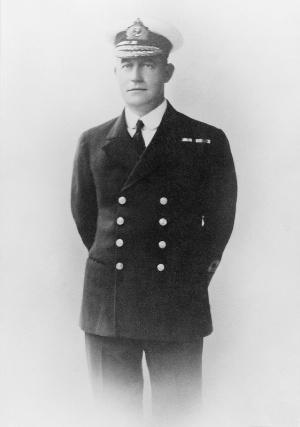
Admiral Sir George Francis Hyde, was an English-born Australian admiral, known as a former head and the first officer to achieve the rank of full admiral in the Royal Australian Navy.

HMCSProtector was a large flat-iron gunboat commissioned and purchased by the South Australian government in 1884, for the purpose of defending the local coastline against possible attacks in the aftermath of the 'Russian scare', of the 1870s. She arrived in Adelaide in September 1884 and served in the Boxer Rebellion, World War I and World War II.
Admiral Sir Victor Alfred Trumper Smith, was a senior officer in the Royal Australian Navy. Smith's career culminated with his appointment as chairman, Chiefs of Staff Committee—forerunner of the role of Australia's Chief of the Defence Force—from 1970 to 1975, following an earlier term as Chief of Naval Staff from 1968 to 1970.
Vice Admiral Rodney Graham Taylor, was a senior officer in the Royal Australian Navy, serving as Chief of Navy from 1994 to 1997. Born in Queensland, Taylor entered the Royal Australian Naval College at the age of thirteen. Graduating as dux of his year in 1957, he later specialised in navigation and served during the Vietnam War. Commanding HMAS Vampire as well as HMAS Torrens, Taylor planned and coordinated the deployment of Australian ships during the Gulf War. Retiring from the navy in 1997, Taylor died from lung cancer in 2002 at the age of 62.
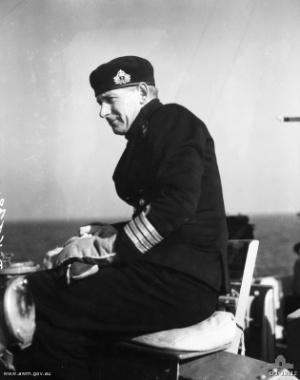
Rear Admiral Otto Humphrey Becher, & Bar was a senior officer in the Royal Australian Navy (RAN). Born in Harvey, Western Australia, Becher entered the Royal Australian Naval College in 1922. After graduating in 1926, he was posted to a series of staff and training positions prior to specialising in gunnery.

Vice Admiral Sir Henry Mackay Burrell, was a senior commander in the Royal Australian Navy (RAN). He served as Chief of the Naval Staff (CNS) from 1959 to 1962. Born in the Blue Mountains, Burrell entered the Royal Australian Naval College in 1918 as a 13-year-old cadet. His first posting at sea was aboard the cruiser HMAS Sydney. During the 1920s and 1930s, Burrell served for several years on exchange with the Royal Navy, specialising as a navigator. During World War II, he filled a key liaison post with the US Navy, and later saw action as commander of the destroyer HMAS Norman, earning a mention in despatches.
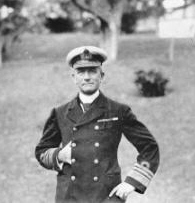
Admiral Sir George Edwin Patey, was a senior officer in the Royal Navy.

Commander Mark Raymond Tandy, is an officer of the Royal Australian Navy (RAN). He joined the RAN as a radio operator in 1982 and rose through the ranks to become Warrant Officer of the Navy in 2008. He relinquished the post in 2012 and was subsequently commissioned as an officer.

Vice Admiral Sir Alan Wedel Ramsay McNicoll, was a senior officer in the Royal Australian Navy (RAN) and a diplomat. Born in Melbourne, he entered the Royal Australian Naval College at the age of thirteen and graduated in 1926. Following training and staff appointments in Australia and the United Kingdom, he was attached to the Royal Navy at the outbreak of the Second World War. As torpedo officer of the 1st Submarine Flotilla in the Mediterranean theatre, McNicoll was decorated with the George Medal in 1941 for disarming enemy ordnance. He served aboard HMS King George V from 1942, sailing in support of several Arctic convoys and taking part in the Allied invasion of Sicily. McNicoll was posted for staff duties with the Admiralty from September 1943 and was involved in the planning of the Normandy landings. He returned to Australia in October 1944.

Vice Admiral Ian Warren Knox AC is a retired senior officer of the Royal Australian Navy (RAN). In a 42-year career, Knox commanded HMA Ships Torrens, Hobart and Melbourne, briefly served as Deputy Chief of Naval Staff, and was Flag Officer Commanding HM Australian Fleet from 1985 to 1987. His career culminated with his appointment as Vice Chief of the Defence Force in January 1987; a position he held until his retirement in September 1989.
Vice Admiral Robert Andrew Kevin Walls, AO is a retired senior officer of the Royal Australian Navy (RAN). In 42 years of service, Walls commanded HMA Ships Tobruk, Moreton and Brisbane, served as Deputy Chief of Naval Staff and Maritime Commander Australia, before his career culminated with his appointment as Vice Chief of the Defence Force from April 1995 until his retirement in March 1997.

Vice Admiral Jonathan Dallas Mead, is a senior officer in the Royal Australian Navy. He joined the navy via the Royal Australian Naval College at HMAS Creswell in 1984, and spent his early career with the Clearance Diving Branch before training as a Principal Warfare Officer. He captained HMAS Parramatta on operations in the Persian Gulf from 2006 to 2007 during the Iraq War and commanded Combined Task Force 150, overseeing maritime counter-terrorism operations around the Arabian Peninsula and Horn of Africa, from 2011 to 2012. He served as Head of Navy Capability from 2015 to 2017, Commander Australian Fleet from 2018 to 2020, Chief of Joint Capabilities from 2020 to 2021, and was appointed Chief of the Nuclear-Powered Submarine Task Force in September 2021.
Rear Admiral Christopher Erson Smith, is a senior officer in the Royal Australian Navy. He has commanded the ships HMAS Gladstone (2002–04), HMAS Darwin (2008–10) and the flagship HMAS Canberra (2015–17), and served as Deputy Chief of Navy from September 2020 to December 2022. He was appointed Commander Australian Fleet on 16 December 2022.













